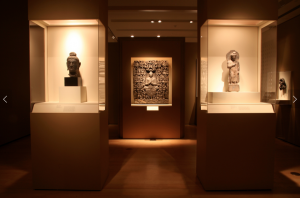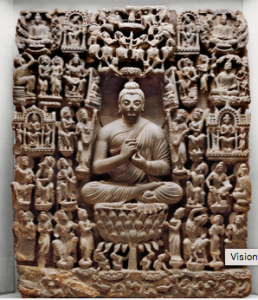
Moving into the next section, the theme of the environment changes once more. Buddhas and Bodhisattvas serves as a wrap-up to the exhibit, a last impression, and delivers beautifully with its evolution of Buddhist sculpture and iconography. The work throughout this gallery places a heavy emphasis on the emergence of the Buddha as a physical representation, moving from Footprint of the Buddha, which was used to represent the spiritual leader without using his image, to full bodied representations of the Buddha.1It is also here that naturalism begins to emerge clearly in the work. Therefore, in a sense, this section serves to present the viewer with a finished picture of the religion as it developed in Gandhara and the region by means of painting an evolution up to the most common image of the Buddha known around the world today.1

This section also includes the exhibition’s highlight Vision of the Buddha’s Paradise. A fourth century CE relief, the artifact represents the accumulation of all the ideas presented and explored within the exhibit, such as iconography, architecture, and cultural and religious development.2The relief, showing the Buddha sitting cross-legged in the center on his iconic lotus blossom and surrounded by smaller Buddhas and Bodhisattvas, shows the Gandharan carvers great prowess for storytelling and representation of larger concepts.1Furthermore, from a purely aesthetic perspective, the work is beautiful and awe-inducing.

- “The Buddhist Heritage of Pakistan: Art of Gandhara.” Asia Society.
- Ed. Proser, Adriana. The Buddhist Heritage of Pakistan: Art of Gandhara.